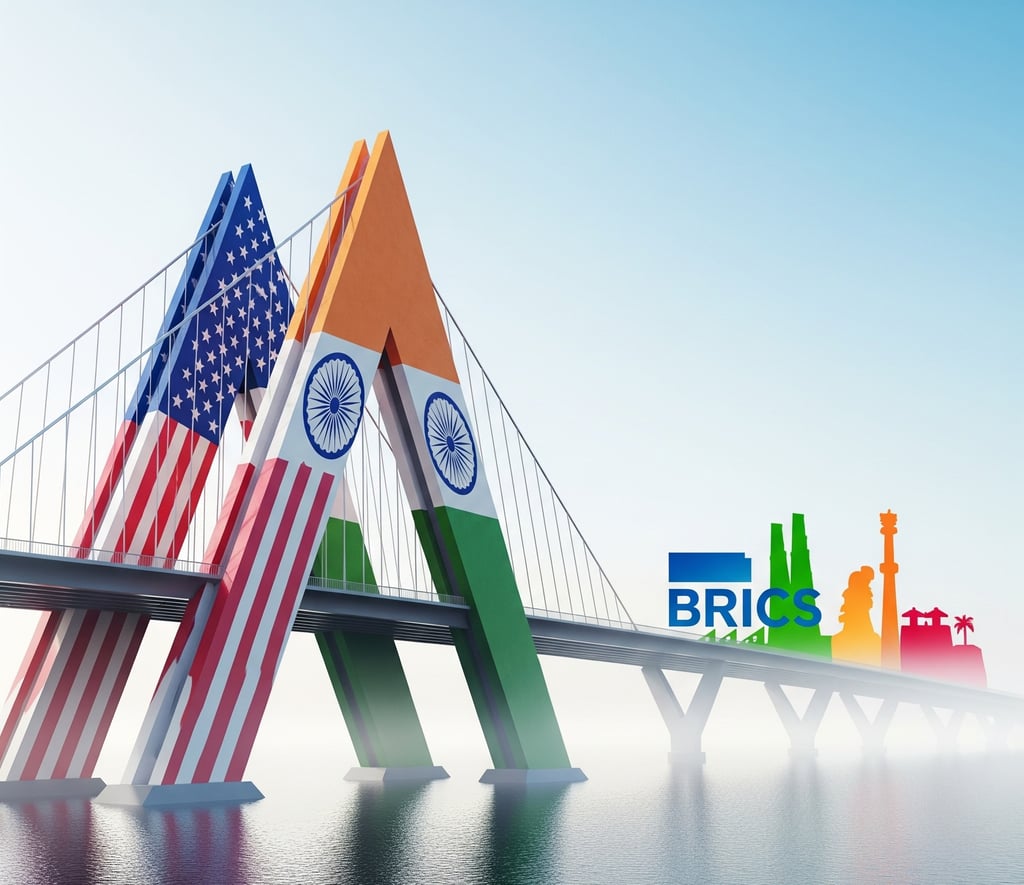Understanding the US-India Trade Deal and Its Challenges Amid BRICS Talks
The United States and India are working on a trade deal to strengthen their economic relationship, but recent BRICS summit discussions have introduced some complications. If you’re curious about what this trade deal entails, its current status, and how BRICS might affect it, here’s a clear and simple explanation for your blog.
INTERNATIONAL TRADETRADE TRENDSINDIA'S TRADETRADE DEALSBRICSUSA
7/10/20253 min read


What Is the US-India Trade Deal?
The US-India trade deal is an agreement aimed at making trade smoother between the two nations. It focuses on reducing tariffs (taxes on imported goods), opening markets, and boosting economic ties.
The goal is to benefit both countries—India wants better access to US markets for products like textiles and fruits, while the US seeks lower barriers for its agricultural and dairy goods in India.
Why It Matters: Trade deals can lower consumer prices, create jobs, and support industries. For India, it’s a chance to grow exports to the huge US market. For the US, it’s about selling more goods like corn, fruits, and energy products in India.
What’s on the Table: A "mini" trade deal is being discussed as a starting point, focusing on specific sectors, with a larger deal possibly later.
Latest News on the US-India Trade Deal:
Here’s the status as of July 10, 2025:
Progress on the Deal: India and the US are nearing a "mini" trade deal, potentially soon after July 9, 2025. India has made its best offer, and the US is now deciding whether to accept it. The aim is to finalize this first phase by September or October, with a goal to double trade to $500 billion by 2030.
Sticking Points: Some challenges remain. India is protective of its dairy and agriculture sectors, which support millions of jobs. The US wants India to lower tariffs on items like corn, fruits, and auto parts, but India has set firm boundaries, especially on dairy and genetically modified crops.
Deadline Pressure: The US initially set a July 9 deadline for talks but extended it to August 1 for India, showing flexibility and a desire to keep negotiations on track.
How BRICS Talks Are Affecting the Deal:
BRICS (Brazil, Russia, India, China, South Africa, and others) is a group of emerging economies that collaborate on trade and economic issues. Recent US concerns about BRICS, particularly from President Donald Trump, have raised questions about the US-India trade deal.
Here’s how:
Trump’s Tariff Threats: Trump has warned that BRICS countries, including India, could face an additional 10% tariff on exports to the US due to their BRICS membership. He’s also threatened 100% tariffs if BRICS nations shift away from using the US dollar in trade, putting pressure on India during trade talks.
India’s Position in BRICS: India supports trading in local currencies (like rupees) but isn’t pushing to fully replace the US dollar, unlike some BRICS members like China or Russia. Indian officials are confident these differences will limit the impact of Trump’s threats.
A Bargaining Tool?: Some believe Trump’s tariff warnings are a tactic to push India into offering more concessions in the trade talks, such as lowering tariffs on US goods. India remains cautious but optimistic about reaching a deal.
BRICS Summit Impact: At the July 2025 BRICS summit in Brazil, talks about trade and reducing reliance on the US dollar were prominent. Trump’s view of BRICS as "anti-American" has added uncertainty to India’s trade negotiations with the US.
What Does This Mean for the Future?
Hope for a Deal: Both countries are motivated to reach an agreement. India’s exclusion from some of Trump’s tariff threats suggests the US is open to compromise. A "mini" deal could soon cover areas like energy, autos, and some fruits, while avoiding sensitive sectors like dairy.
BRICS Complications: India’s role in BRICS could create challenges if the US imposes tariffs, but India is trying to keep its BRICS commitments separate from its US trade goals.
Why It’s Tricky: India wants to protect its farmers and industries, while the US seeks greater market access. Trump’s unpredictable trade policies add complexity.
Key Takeaways for Learners
Trade Deals 101: These agreements make trade easier by lowering tariffs and opening markets.
US-India Deal Status: A small deal is close, but issues like dairy and agriculture are hurdles. The August 1 deadline offers hope for progress.
BRICS Drama: Trump’s tariff threats against BRICS countries could complicate things, but India is working to balance its roles in both BRICS and the US deal.
Why It’s Important: A successful deal could boost jobs, lower prices, and strengthen US-India ties, but it requires compromise.
Thanks to Hindustan Times, Times of India, Reuters, Moneycontrol, Business Standard, India Today, News18, The Hindu, and Business Today.

Astan Finserv Consultancy Services
Export Consultation, Export and Customs Documentation, Duty drawback and Indian Govt Export Schemes and Export Trainings.
© 2025. All rights reserved.